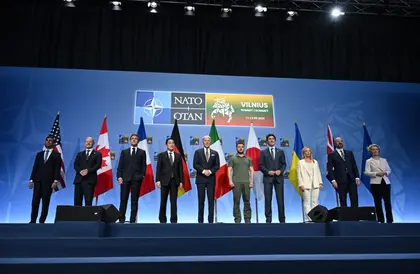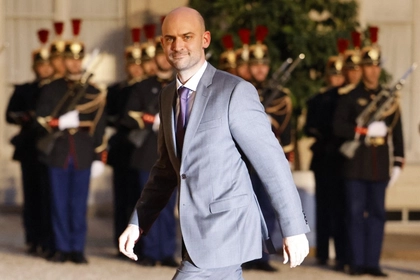As is traditional after such a high-level meeting as the NATO Summit, a formal communique was issued to give a detailed overview of what was agreed upon.
It runs to 90 closely typed and detailed paragraphs which, if you want to read it in full, can be found here.
JOIN US ON TELEGRAM
Follow our coverage of the war on the @Kyivpost_official.
If you’d rather not dedicate most of your day to that monumental task, Kyiv Post has summarized the discussions and decisions taken in, not only the main leaders’ meetings, but also the subsidiary gatherings of the foreign ministers, defense ministers and the military committees.
Naturally the new NATO-Ukraine Council, the security assurances and guarantees provided to Kyiv by the Alliance, the G7 partners and bi-laterally by member nations captured the headlines, as did the 11th hour agreement by Turkey to accept Sweden’s accession.
There are, however, some equally significant developments buried within NATO’s dispatch.
Defense spending
One of the big-ticket items was the agreement on the national defense budgets of member states which currently lists the 2% of Gross Domestic Product (GDP) target as “aspirational.”
It was agreed at Vilnius to set 2% of GDP as the minimum national annual contribution to defense. This is considered to be necessary to resource newly agreed Capability Targets defense plans and force model and to fund NATO operations, missions and activities.
![[VIDEOS] North Korean Troops in Russia Confirmed](https://static.kyivpost.com/storage/2024/10/19/a6f6a4c5d74d066019e5812a20c6514f.png?w=420&q=75&f=webp)
[VIDEOS] North Korean Troops in Russia Confirmed
It was further agreed that a minimum of 20% of the defense budgets would be used to provide major equipment, develop and modernize forces and capabilities, including the integration of innovative technologies.
The breakdown of the current estimated contributions made by each member for 2023 is shown in the table below:

| Estimates of percentage of GDP allocated to defense by NATO members in 2023Source: NATO HQ |
Russian aggression
The communique states in the strongest possible terms that NATO holds Russia fully responsible for its war of aggression against Ukraine for which it must be held fully accountable. The members of the Alliance unequivocally condemn Russia’s blatant violations of international law, the UN charter, and the principles of the OSCE commitments and principles.
It goes on to say that NATO does not and will never recognize Russia’s illegal claims and unlawful annexation of Ukrainian territory, including that of Crimea. The Kremlin must be held accountable for its abuses of human rights and international humanitarian law, particularly against Ukraine’s civilian population and for atrocities such as the destruction of the Kakhovka dam.
NATO demands that Russia must stop its illegal war of aggression, cease its use of force against Ukraine, and completely withdraw all of its forces and equipment from the internationally recognized territory and waters of Ukraine. The Alliance urges all countries to cease any kind of assistance to Russia’s aggression and identifies Belarus and Iran as being complicit in Moscow’s illegal war.
The comprehensive assistance package to Ukraine (CAP)
The CAP remains a priority for NATO its members having committed over 500 million Euros since the Madrid Summit of June 29-30,2022. It was agreed in Vilnius to develop the CAP into a multi-year program designed to rebuild the Ukrainian security and defense sector and transition Ukraine towards full interoperability with NATO. Allies have agreed to continue to fund the CAP in a sustained and predictable way.
Strengthening NATO’s collective defense
It was agreed to further enhance NATO’s deterrence and defense posture in all areas including pre-positioning of additional forward [East-facing] defenses and establish an enhanced ability to rapidly reinforce areas under threat. Allies will provide increased levels of forces at high readiness, to include a new multinational Allied Reaction Force.
A number of Allies have undertaken to increase their presence on NATO’s Eastern Flank [e.g. Germany to permanently deploy a brigade to Lithuania] and to further improve the readiness, preparedness, and interoperability of NATO’s Integrated Air and Missile Defense within SACEUR’s Area of Responsibility, with an initial focus on the Eastern Flank.
Plans to support the Alliance’s defensive capabilities, particularly to deploy its reaction forces and reinforce areas threatened will be increasingly tested by a new series of exercises which will improve the capacity for logistical sustainability of field forces.
Nuclear deterrence
The Alliance recognizes attempts by both Russia and China to modernize their nuclear forces and the development of dual-capable delivery systems, many of which have been used by Moscow to attack civilians and critical civilian infrastructure in Ukraine.
The Alliance condemns the deployment of nuclear weapons and nuclear-capable systems to Belarus, another example of Moscow’s efforts to destabilize strategic security in the Euro-Atlantic area.
As long as nuclear weapons exist, NATO must retain appropriate nuclear capability even though it considers their use to be extremely remote.
The strategic nuclear forces of the Alliance, held by the US, the UK and France as separate decision-making centers contribute to deterrence by complicating the calculations of potential adversaries.
The forward deployment of US nuclear weapons forward-deployed in Europe supported by host nation dual-capable aircraft conventional forces and military capabilities remain central to NATO’s nuclear deterrence efforts.
NATO plans to enhance its ballistic missile defense (BMD) capabilities in light of the increased ballistic missile threats from outside of the Euro-Atlantic area. This will, in due course, provide full coverage and protection for all NATO European populations, territory, and forces against the increasing threat posed by the proliferation of ballistic missiles.
People’s Republic of China (PRC)
NATO considers that the PRC is expanding its political, economic, and military strength while concealing its wider strategic intentions. The PRC is engaging in a range of hybrid and cyber-based operations supported by confrontational language and disinformation which threatens the Alliance’s security. In particular it employs its economic power to boost its influence internationally.
NATO wishes to retain a constructive relationship with the PRC, based on two-way transparency, while retaining the ability to protect the Euro-Atlantic area.
The communique highlighted the partnership between the PRC and Russia in their attempts to subvert the rules-based international order. NATO calls on China to use its influence, particularly within the UN Security Council, to help bring Russia’s war of aggression against Ukraine to an end, and to abstain from supporting Russia’s war effort in any way.
Defense industry base
The war in Ukraine has identified that current stocks of weapons and munitions are insufficient to provide forces with the capability to implement NATO’s existing and future defense plans. Member nations must ensure that Alliance forces are ready and have the necessary personnel, equipment, training, spares, logistics, infrastructure, and stockpiles to support war fighting capability in line with NATO standards and doctrines.
This will require development of a stronger defense industrial base in Europe with greater cooperation within Europe and the Atlantic.
Miscellaneous
The communique includes sections relating to “more esoteric” areas including combating climate change, cyber warfare, terrorism and low intensity conflict. If you wish to learn more, open the link at the beginning of this article.
You can also highlight the text and press Ctrl + Enter






